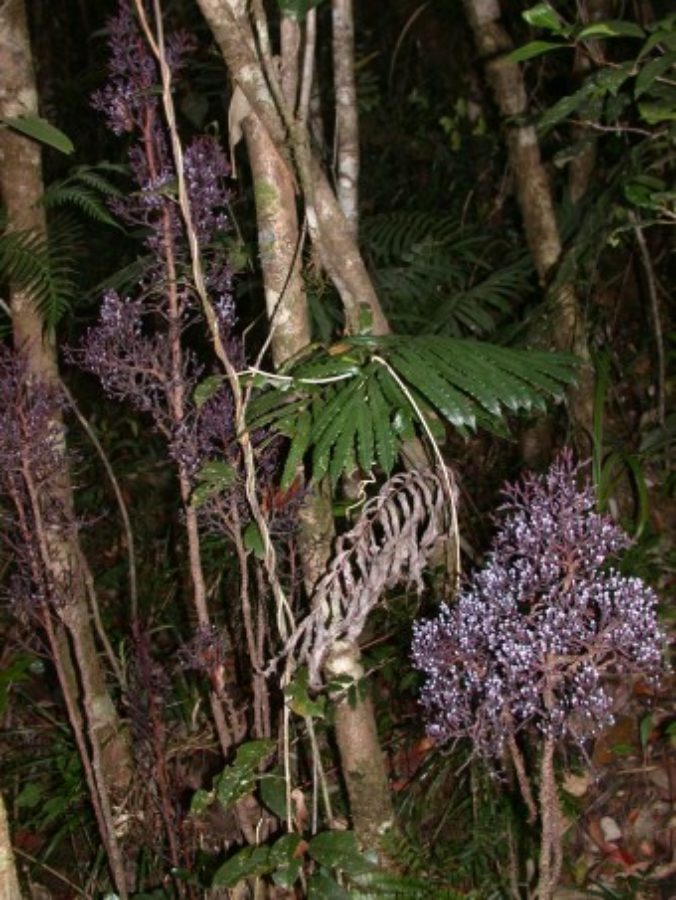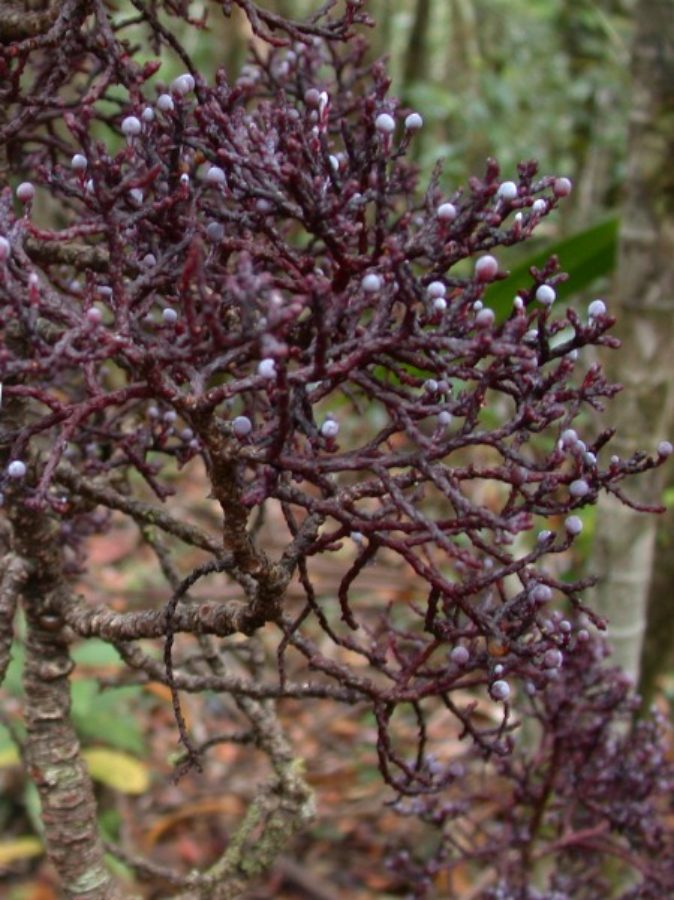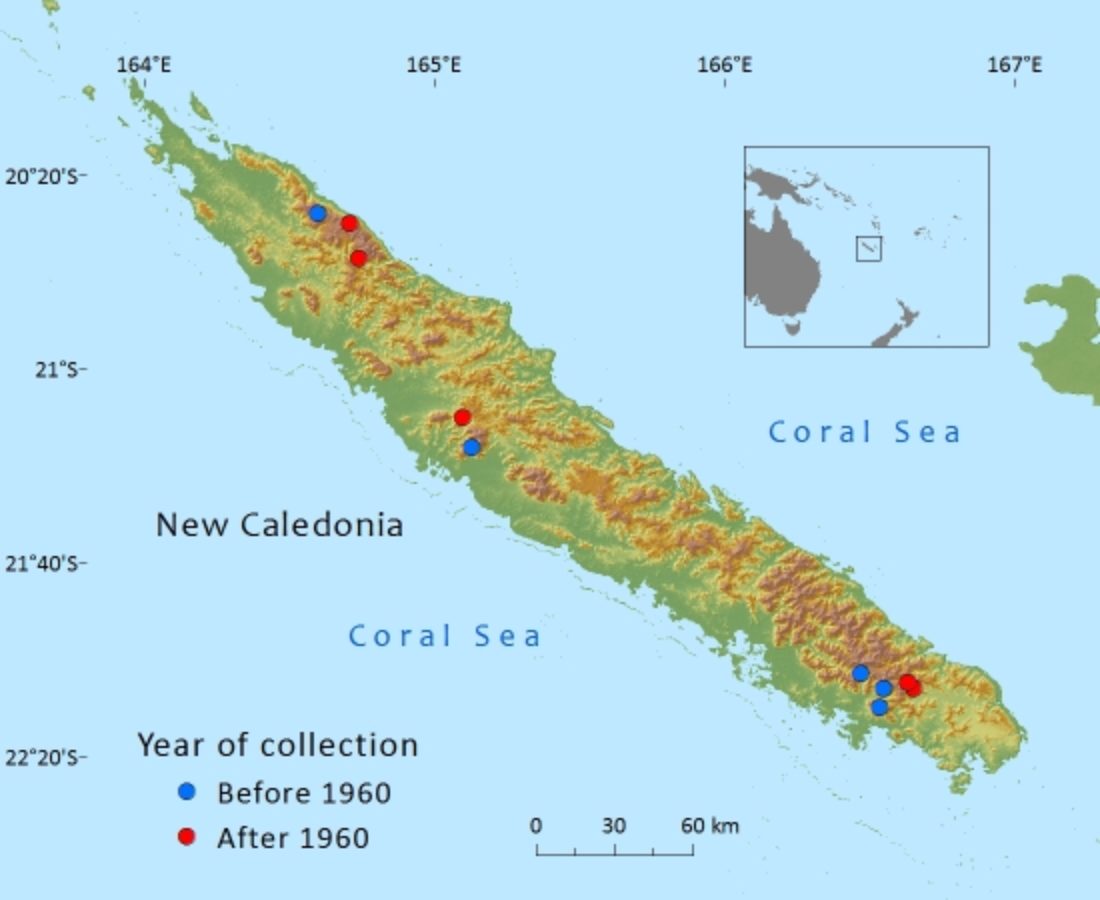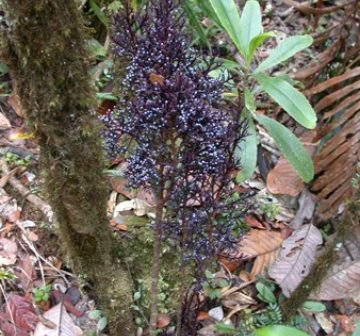Podocarpaceae
Parasitaxus usta
This, the only known parasitic conifer species is endemic to New Caledonia where it's host is the conifer Falcatifolium taxoides.
Description
Habit
Small, erect monoecious shrub 1–1.5m tall, usually multistemmed. Bark thin, with large lenticels, Branches many, spreading and ascending, contorted, upper covered with reddish scale leaves.
Foliage
Leaves scale-like, spirally arranged, overlapping, 2–3 x 1–2mm, broadly lanceolate, apex appressed or free, obtuse or acute. Stomata on both sides of the leaves.
Cones
Male pollen-cones occur on same branches as female seed-cones, terminal, solitary, 3–3.5 x 1.5–2mm. Female seed-cones mainly terminal consisting of 3–6 spreading red bracts, fertile scales with a single termianl inverted ovule. Seeds surrounded by a globose, hard glaucous white epimatium, 3–4mm across.
Notes
The parasitic on the endemic species Falcatifolium taxoides. This is the only known parasitic conifer species
References and further reading
- Cherrier, J. F. (1981). Le Parasitaxus ustus (Vieillard) de Laubenfels. Rev. Forest. Fr. 33: 445–448.
- Cherrier, J. F., Giraud, M., Ghiglione, C. & Woltz, P. (1990). Parasitisme interspécifique chez les Gymnospermes. Étude comparative des acides aminés. Rev. Cytol. Biol. Vég. Botaniste 13: 191–197.
- Cherrier, J. F., Gondran, M., Woltz, P. & Vogt, G. (1992). Parasitisme interspécifique chez les Gymnospermes. Données inédites chez deux Podocarpaceae endémiques Néo-Calédoniennes. Rev. Cytol. Biol. Vég. Botaniste 15: 65–87.
- Field, T.S, & Brodribb, T.J. (2005). A unique mode of parasitism in the conifer coral tree Parasitaxus ustus (Podocarpaceae). Pl. Cell Environm. 28: 1316-1325
- Jaffré, T., Munzinger, J. & Lowry, P.P. (2010). Threats to the conifer species found on New Caledonia's ultramafic massifs and proposals for urgently needed measures to improve their protection. Biodiversity & Conservation 19(5):1485-1502.
- Köpke, E., L. J. Musselman, & D. J. De Laubenfels. (‘1981’ publ. 1983). Studies on the anatomy of Parasitaxus ustus and its root connections. Phytomorphology 31(1–2): 85–92
- Seyfullah, L.J., Beimforde, C., Perrichot, V., Rikkinen, J. & Schmidt, A.R. (2017) Parasitaxus parasitized: novel infestation of Parasitaxus usta (Podocarpaceae). Arthropod-Plant Interactions 11:507–514
- Sinclair, W. T., Mill, R. R., Möller, M., Gardner, M.F., Woltz, P., JaffréT., Preston, J., Hollingsworth, M. & Ponge, A. (2002). Evolutionary relationships of the New Caledonian heterotrophic conifer, Parasitaxus usta (Podocarpaceae), inferred from chloroplast trnL-F intron / spacer and nuclear rDNA ITS2 sequences. Plant Syst. Evol. 233: 79-104.
- Stockey, RA, Ko H & Woltz P. (1995). Cuticle micromorphology of Parasitaxus de Laubenfels (Podocarpaceae). Int. J. Pl. Sci. 156(5): 723–730.
- Thomas, P. (2010). Parasitaxus usta. In: IUCN 2012. IUCN Red List of Threatened Species. Version 2012.1. www.iucnredlist.org. Downloaded on 29 June 2012.







